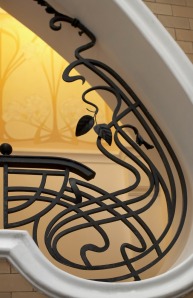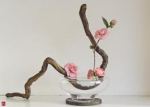![1912 Pines by the Sea - Bertha Lum]()
1912 Pines by the Sea – Bertha Lum
Art Nouveau was heavily inspired by Japanese Art, and in particular by Japanese Wood Block Prints; it was just last year when I wrote about this phenomenon called Japonism in my post on Siegfried Bing. And because my Journey into Art Nouveau still continues, I discover something new every day. Today I discovered Bertha Lum…
![Bertha Lum (1869 – 1954)]()
Bertha Boynton Bull was born May 1869 in Tipton, Iowa. Her father, Joseph W. Bull (1841–1923), a lawyer, and her mother Harriet Ann Boynton (1842–1925) were both amateur artists.
In 1885, Bertha attended the Art Institute of Chicago for one year focusing on design. A few years later she studied stained glass with Anne Weston and illustration with Frank Holme. Her aesthetic sensibilities were further shaped by the display of Japanese prints at the 1893 World’s Columbian Exposition in Chicago and by Arthur Wesley Dow’s influential textbook Composition (1899), which promoted Japanese color woodcuts as models. It is said Bertha was also influenced by Lafcadio Hearn, who translated Japanese legends and fairy tales into popular books. (And I guess it gives me a sense of connectedness since my friends and I used to read Lafcadio Hearn’s Haiku’s back in the 1990s when I lived in Japan.)
![1912 Cherry blossoms - Bertha Lum]()
![1912 Peter - Bertha Lum]()
![1912 Two Children - Bertha Lum]()
In 1903 Bertha married Burt F. Lum, a corporate lawyer from Minneapolis, Minnesota, and persuaded him to travel to Japan on their honeymoon. It was her first of many adventures in the Orient.
![1905 The Home Coming - Bertha Lum]()
![1905 Theatre Street Yokohama - Bertha Lum]()
![1907 Evening - Bertha Lum]()
“Before I went to Japan, I thought that print makers were as easy to find as paper lanterns or kimonos but after I spent six weeks asking everyone who spoke English – guides, rickshaw boys, hotel proprietors and curio dealers – were I could buy tools and see them make prints, and found no one to tell me, I became utterly discouraged and only succeeded the week before I sailed back home, in being directed to a shop where they reproduced old prints, and it was an hour spent there that gave me all the knowledge I had of the process aside from what I had learned from books.
This shop, as great favor, allowed me to pay $20 for thirteen tools (and I was glad to get them at any price) though I found on a later trip that they were of inferior grade and I then bought fifty of the best for $5.
When I returned home I added to the knowledge gained in this short time by reading everything obtainable on the subject, and started to make prints.”
![1904 China Boy - Bertha Lum]()
![1916 Pinetree Fairy - Bertha Lum]()
![1907 Sisters - Bertha Lum]()
![1907 O Fuji San - Bertha Lum]()
![1904 In the Garden - Bertha Lum]()
Back in the U.S. she produced some lovely prints like “China Boy” or “Lanterns”. Three years later (1907) she returned to Japan for fourteen weeks with an introduction letter to Igami Bonkotsu (1875-1933), a master block cutter in Tokyo. Bonkotsu disclosed to her the techniques of carving and arranged for her education in block printing.
“…The next day we started early and went miles and miles far into the suburbs of Tokyo, down back streets and finally at the end of an alley, where the poorest people lived, in a very small house of four rooms, we found the man who was supposed to cut the best blocks in Tokyo – and there I worked every day for two months. My teachers were mostly two apprentices of twelve years of age, “the master” coming in once or twice a day to approve, or mostly disapprove, of my progress.”
The master carver was Igami Bonkotsu.
![1916 The Piper - Bertha Lum]()
1916 The Piper – Bertha Lum
After having learned how to cut, she went to the printer (Kamakichi Nishimura) and there again she stayed many weeks watching young apprentices color in her own prints.
“When I was ready to stop cutting blocks, accompanied by the professor and “the master” I was taken to another part of the city and presented with due ceremony to the printer. We drank tea and ate cake for two hours and all was arranged for me to begin work the next morning. I went every day for four weeks and did no printing but watched the man work out my ideas from the blocks I had cut. It was in a part of the city where foreigners never go and when I appeared at the end of the street it would immediately fill with men, women and children and when we reached the house my rickshaw boy go so near I could slip into the front door. We worked in a room on the first floor with only the paper shojii between us and the mob, all that could come near enough, would wet a finger, punch it through the paper and then use the hole as a peep-hole and you could look up any time and see a dozen or more eyes watching and the entire screen would have to be recovered each day after my departure. None of these people spoke a word of English my Japanese was only useful in bargaining fo junk so you see there were some difficulties to be overcome.
![1908 Through the Night - Bertha Lum]()
1908 Through the Night – Bertha Lum
I had no interpreter when cutting blocks but wanted one for the printer but the best I could find was my « riksha boy » who found it so much more interesting to sit on the floor and say “Too much blue”,”More water” and similar remarks than pulling people about in a Jinriksha that I found him much more useful than a regular guide who would have been too bored to be of service, considering such work beneath his dignity.
Had I not had the second letter of introduction my second trip would have been entirely wasted. Everything in Japan is very easy for the tourist. Ivories, embroideries, curios, bronze await you in the shop, are brought to your hotel – you cannot escape them – but if you want something of the people, learn an art or buy something purely Japanese, you face a wall. There are no openings, it is too high to go over and if you try to walk around you only go in a circle and soon return where you started.
I returned to America and for three years worked out things that interested me, trying to add my ideas to theirs, and last year decided to take a house in Tokyo for the winter, send for my old printer and enjoy myself.”
![1909 Winter - Bertha Lum]()
1909 Winter – Bertha Lum
In 1911, Bertha and her daughters Catherine Balliet Lum and Eleanor Peter Lum stayed in Japan for 6 months. During her early years, Bertha had insisted on carving and printing her own prints, and she became masterful at both skills. However on subsequent trips to Japan, she decided to hire carvers and printers to work under her direct supervision. The Japanese system of collaborative printmaking was more practical and efficient than working alone. It made sense for Bertha to work this way, as she was not only trying to establish herself as an artist, but also to raise two young children.
![Family printing - Bertha Lum]()
Eventually, Bertha moved easily within Japanese society and hers were the only foreign woodcuts in the Tenth Annual Art Exhibition in Tokyo in 1912 where they were admired for their distinctive blending of western and Japanese styles. Her color woodcuts were awarded the silver medal at the 1915 Panama-Pacific International Exposition and her work was included in the 1919 Exhibition of Etchings and Block Prints at the Art Institute of Chicago. She authored and illustrated Gods, Goblins and Ghosts in 1922 and Gangplanks to the East in 1936. Lum’s work received honors in Rome, Paris and Portugal and is represented in the Library of Congress, the Metropolitan Museum of Art and the Achenbach Foundation for the Graphic Arts.
![1920 Three Wise Men - Bertha Lum]()
1920 Three Wise Men – Bertha Lum
In 1922, Bertha moved to Peking, China, but returned to the United States in 1924. She lived in California until 1927, and then moved back to China. The following year she divorced Burt Lum and in 1933 returned again to Peking. In 1953, at age 84, she moved to Genoa, Italy to live with her daughter Catherine. She died in Genoa in February 1954.
The fact that there aren’t many people familiar with this obviously extremely talented artist may have something to do with the 1923 earthquake in Tokyo during which most of Bertha’s blocks and woodcuts were destroyed.
![1918 Mother West Wind - Bertha Lum]()
1918 Mother West Wind – Bertha Lum
Red haired, with green eyes and a strong personality, she managed to establish herself as an artist in Asia as well as in America. Her personal style of sinuous Art-Nouveau curves with flat planes of color that go back to 19th century ukiyo-e pleased both cultures at the beginning of the last century and it still moves me today. I am totally in love with her work and I am just so very sorry we never got to meet…
Sources
Bertha Boynton Lum on Blogspot
wikipage of Bertha Lum
www.bertha-lum.org
Hanga Gallery
IFPDA
Download ‘Composition’ by Arthur Wesley Dow
Tagged:
Art Nouveau,
Arthur Wesley Dow,
Igami Bonkotsu,
Japonism,
Jugendstil,
Lafcadio Hearn,
Nishimura Kamakichi,
Ukiyo-e,
Woodblock Print ![]()










































































































































































































































 The panel on the right got me rather excited because of its thistles. Thistles, you should know, are the symbol of
The panel on the right got me rather excited because of its thistles. Thistles, you should know, are the symbol of 




























































